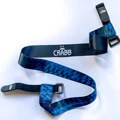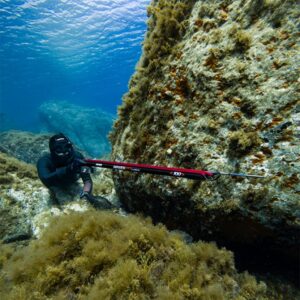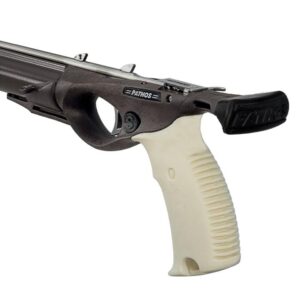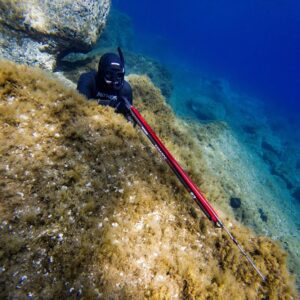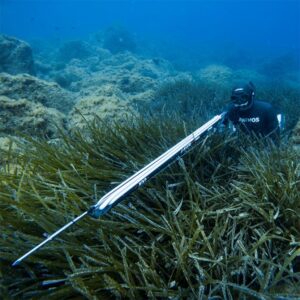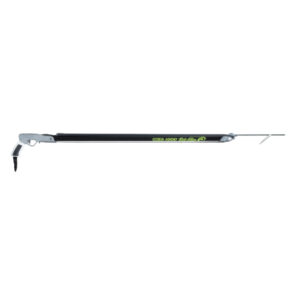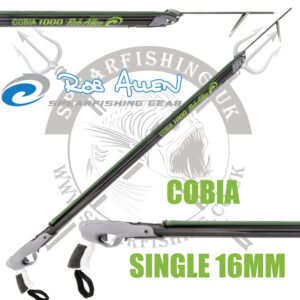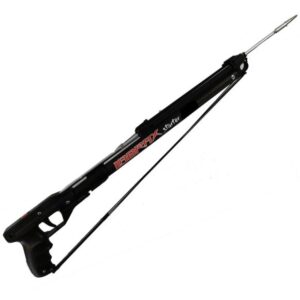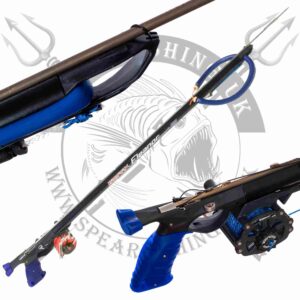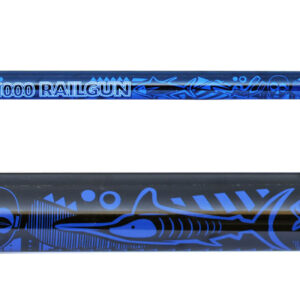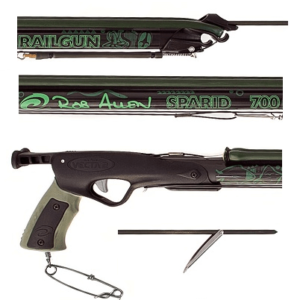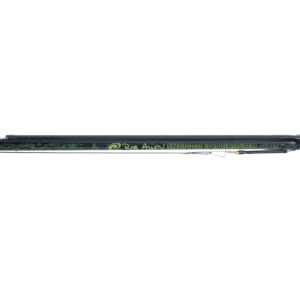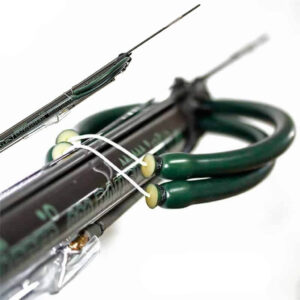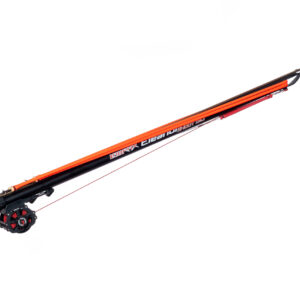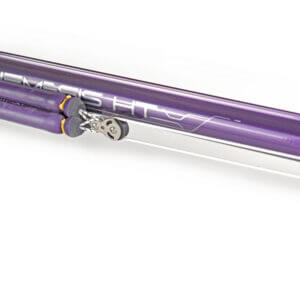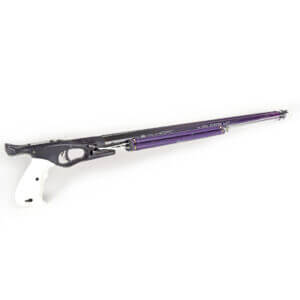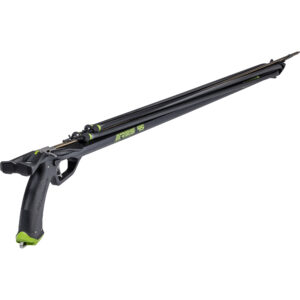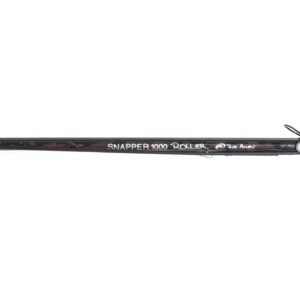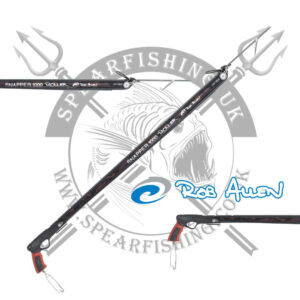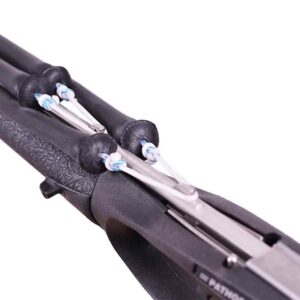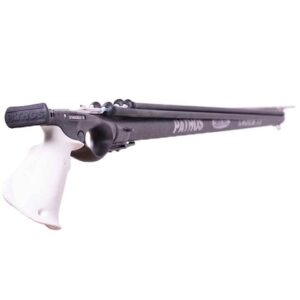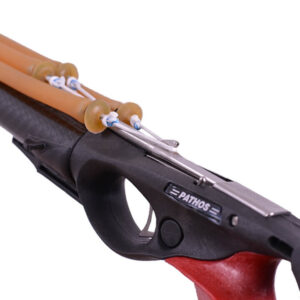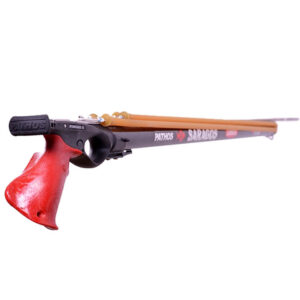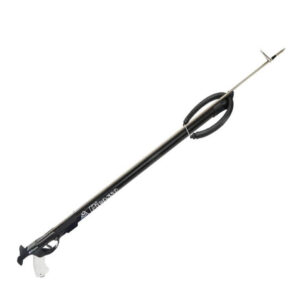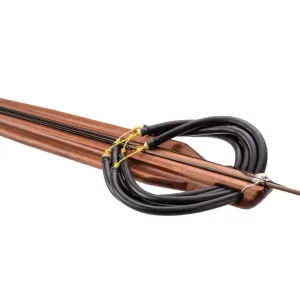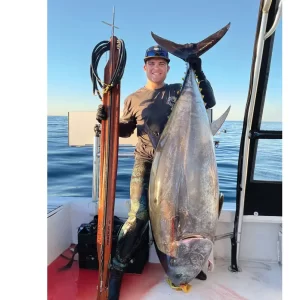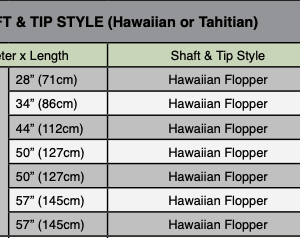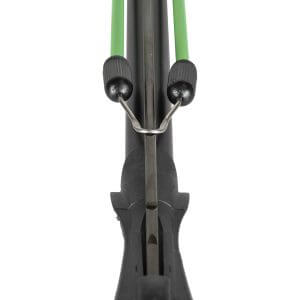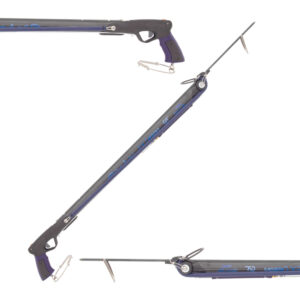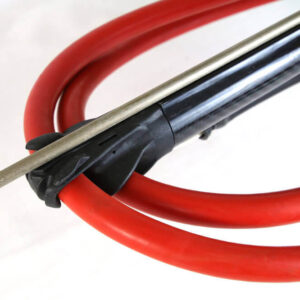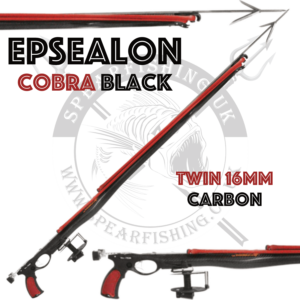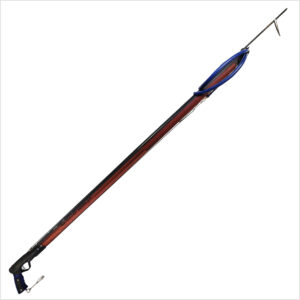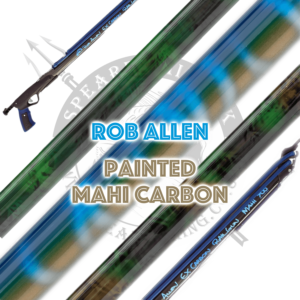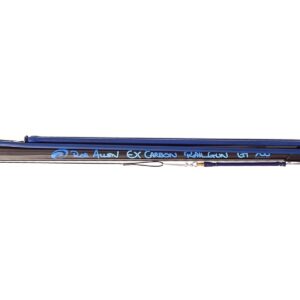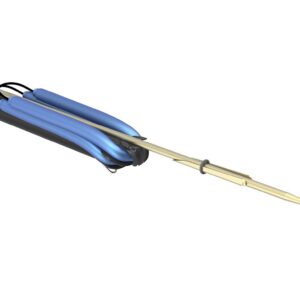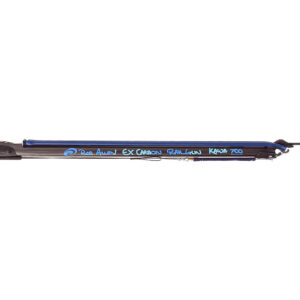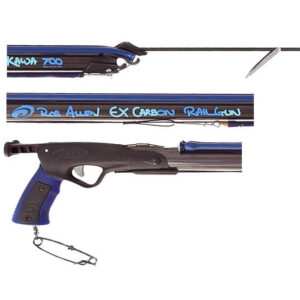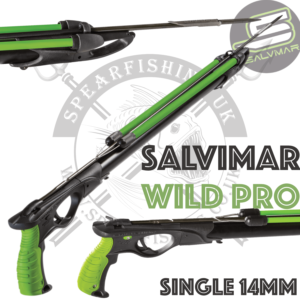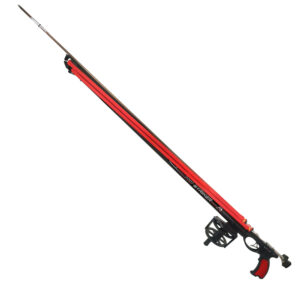Spearguns
We genuinely do have the largest speargun range for sale in the UK – see for yourself! You’ll find over 85 models of spearguns from the world’s leading brands (we have a fantastic relationship with 44 brands including the gods of spearfishing Rob Allen, Salvimar, Pathos, Riffe and many more), each available in many lengths/configurations. You’ll notice that we don’t list each length individually to try and inflate the size of our range.
With so many spearguns on the market surrounded by so much hype, where do you start looking and how do you choose what’s right for you? Which brands are robust, how many bands should you use, what if you want to use it abroad?
For the answers to these questions and more, grab your copy of the most comprehensive Speargun Buyer’s Guide you will find this part of the globe here: Speargun Buyer’s Guide. No fancy marketing talk – just facts, some basic physics and everything else you may want to know. Get the basics or dive deep into the detail – we have put it all into one place for you.
As we have pretty much every speargun for sale that’s worth selling on the global market, we have zero motivation to convince you one way or another. Our only goal is to make sure you get the best gun for you, your hunting style, your most common conditions and at a price you’re happy with. If you don’t fancy reading through this guide then feel free to pick up the phone and we’ll be happy talk you through it all.
Quick links:
- “Show me only spearguns!” >>> – spearguns
- Download our free Speargun Buyer’s guide (PDF).
- Guns and accessories clearance items
- Speargun FAQs
- Chris’ top speargun recommendations for 2023-2024
Need help? Call us on 01726 213290 or email: enquiries@spearfishing.co.uk
Showing 1–48 of 222 resultsSorted by latest
Our top speargun recommendations:
Below £100
Labrax Starter & Salvimar Wild Pro
£100 – £150
Rob Allen Cobia, Salvimar V-Pro Mono-rail & Labrax Eleanor Expert, Labrax Falcon Open
£150 – £200
Rob Allen Snapper, Labrax Eleanor Shoot, Siglasub Nemesis Pro, Salvimar Ares
£200 – £300
Rob Allen Snapper Roller, Rob Allen Tuna Roller, Rob Allen Kawa Carbon, Salvimar Nightmare, Epsealon Spartan Carbon
£300 – £500
Sigalsub Nemesis Pro Carbon, Pathos Laser Carbon Roller, Rob Allen GT Carbon Roller
£500+
Riffe Euro Travel, Orca Evo, Rob Allen Timberline Roller
Polespear top picks
Salvimar Polespear 14 with additional flopper tip, Epsealon Ocean Aluminium 140/190, Headhunter Predator Carbon Roller 8ft
A buyer’s guide to Spearguns
You can also download this guide as a PDF: Speargun Buyer’s Guide. Scroll to the top to see our spearguns for sale. Need help? Call us on 01726 213290, email: enquiries@spearfishing.co.uk or message us using the Messenger icon (bottom right of the page).
Which is the ‘best’ speargun to buy?
This is the great debate that has raged through the ages… many drunken arguments have started and ended right here with that very question. The truth is, there is no one specific speargun or setup that is perfect for all conditions, situations, and hunting style. That is a fact, no matter what people may say.
Gun selection, like many things, is a process of compromise – compromising in the areas that will impact you the least – to ensure that you’re choosing the configuration that will benefit you the most. You need to work out what aspects are most important to you, to your most likely conditions and your preferred hunting style. We can break everything down so you can make an informed choice and dispel some myths along the way.
1. Speargun length
All spearguns have a number attached to them. You will hear people say, ‘I have Rob Allen 90’ or ‘I have a Pathos 82’. This number relates to the length of the gun and is a major consideration to your purchase.
Many people new to the sport think it’s the overall length including the spear but this is not the case. Gun length classifications are determined by measuring the barrel length excluding the gun handle and muzzle. The handle and muzzle add about 20cm or so to the described length and the spear adds up to 40cm more.
With many guns now having a reverse trigger mechanism, a more accurate way to compare guns would be to measure from the band holes to the trigger mech, as a reverse mech adds about 8cm to the draw length of the band. That’s almost the same power as the model up.
What is the best speargun length for the UK?
There is no specific answer to this question so don’t be told otherwise. It all depends on the type of hunting you will be doing and the quality of the visibility you’re likely to be hunting in.
Short spearguns are easier to manage in poor visibility. You’ll be shooting at short ranges and you’ll need to track your gun swiftly from side to side. The shorter the gun, the easier and quicker it is to track and acquire your target at short range.
Conversely, on those epic days where the visibility is 15m plus and the fish just won’t come close, that short gun will feel like you’re trying to be a sniper with a pistol. A longer gun will add stability to shots, give you some extra range and generally be more effective for longer range hunting.
This brings us on to what type of hunting you will be doing the most: poking around in holes or ambushing your targets from a distance. If you’re new to spearfishing then you probably don’t have a clue what type of hunting you’ll prefer so here’s a very quick guide.
Types of hunting
Shallow water hunting: This is the best place to start your spearfishing journey: stalking the shallows in a metre of water, learning what type of kelp holds different types of fish. Learning to stalk silently, learning to ambush in string weed – it’s just fantastic. Not only will you learn a multitude of different hunting skills that you’ll carry with you through your spearfishing career, but you’ll also have the very real possibility of landing BIG fish. Fish like to warm themselves in the shallows and digest that last big meal – and this includes the big ones too! Shallow water hunting also gives you a relatively safe environment to get to know all that new equipment without having to worry about breath hold. All that new gear is going to feel pretty awkward at first, so this is a great ground to become accustomed to it. This type of hunting favours a short range, quick and nimble speargun around 70cm – 75cm.
Ambush hunting: This technique involves diving to the seabed, hiding yourself the best you can and shooting any curious or unaware fish that swim by. Again, this is another great starting point for new aquatic hunters and tends to be their first exposure to hunting on a breath hold. Fish are curious by nature and will present some easy shots for those who can remain still enough and not spook them away. Here you will learn about conserving energy to maximise your O2 as well the importance of choosing a premium ambush site to maximise your chances of success. Gun length for this hunting style is largely dictated by the quality of the visibility. If you have great visibility then a longer speargun will serve you well. In countries which commonly have great visibility, a 110cm – 120cm speargun is very common for reef hunting ambush style – so guess what, the same will work in the UK. In the UK, we’ve used a 110cm with great effect on those crystal clear water days – especially when the fish are being skittish or when the larger specimens are staying on the outside of the shoal. This is quite the mono mission length though – don’t expect to be poking around in holes with guns like this.
Seabed stalking: This consists of diving down and gliding over the seabed a few metres above it: either looking for fish hiding in the kelp, or smoothly floating over the gullies looking for resting bars of protein. This normally favours a shorter gun of around 70 – 80cm but again it can depend on how good the visibility is. If it’s good you can do this from the surface and either shoot from there or drop down on your targets depending on depth. We’ve done this with longer guns on good visibility days, even from the surface on a low tide. When the vis is poorer and you need to be closer to the kelp canopy – a shorter gun works better.
Hole hunting: This is probably one of the most satisfying hunting techniques to take a fish with. It involves getting right ‘in and amongst it’ – stealthily peering into holes and caves looking for fish taking shelter. This is a challenging skill to master, with many hunters failing to ever achieve its lofty heights. This type of hunting is made infinitely easier with a shorter gun. For pure hole hunting you would be happy with a 50-60cm gun as long as it had the punch to take big fish, as that is often the reward for successfully taking a fish from its lair.
So which is the right speargun for you?
Well by now you can probably tell that it’s a process of elimination and there is no one gun that is perfect for all situations. Many shore divers will take out two guns to try and cover multiple situations and hunting styles, leaving the spare attached to their dive float and switching when needed. Most new spearfishermen will cut their teeth in the shallows and mix in some seabed ambushing while they get used to operating underwater with their new gear.
As a general guideline, something between 75 and 90cm is a good range to be looking at for your first ‘do it all’ speargun. If you are drawn to a particular hunting technique or know the typical visibility for your area, then let the length lean towards what favours those the most. Commonly we’ll take a 60cm and a 90 or 110cm, for the typical conditions and hunting we do in Cornwall. Further east where they have less kelp, less vis and more access to holes, they may lean more towards 50s and 75s. At the end of the day, you really can’t go too far wrong with any decision within these parameters. As you progress through the sport you’ll likely acquire several guns and soon learn what lengths work for you and when.
2. Gun bands and spears: finding harmony
Bands and spears are a harmonious relationship between tensile strength and power. An overpowered spear will flex and lose its accuracy. An underpowered spear will drop low on its target and lack penetration.
Luckily you don’t need to think about these aspects too much as your manufacturer will have already done all this for you. They will present you several configurations for the same speargun to choose from, commonly:
- a single 16mm band
- twin 14mm bands, or
- twin 16mm bands.
Each option will have its own specific spear, with their diameters ranging somewhere between 6 – 7.5mm.
14mm bands have the bonus of being easier to load, making them popular for people concerned about their strength. Yet having two of them on your gun will be nice and powerful.
With all other things being equal, a thicker spear will have more tensile strength than a thinner one – allowing it to be shot at a higher velocity than a thinner spear before it becomes inaccurate.
However, a thicker spear has more weight, meaning you need a speargun stock with more weight to minimise its recoil and muzzle flip. Muzzle flip is your speargun’s desire to rotate upwards at the tip, from the central point of the handle when fired.
If you are considering long range for clear water, then twin 16mm bands will add about 30 – 40% more range after you have double wrapped your shooting line.
If you are looking to hunt at short range then the demands placed on the gun’s design are less important. A thinner spear with a single band is very popular. The lighter spear puts less weight demands on the speargun so it’s easier to track from side to side. The effects of inaccuracy are felt less, the closer the target is that you are firing at.
However if you want to maintain a speargun’s accuracy at the longer ranges while still being quick to track, you can look at mid handle guns. This is where the handle is moved part way up the gun barrel while the trigger mech remains located at the rear. This makes a 90cm gun feel and handle like a 75cm gun. So you get bigger gun action out of a smaller more manageable unit.
3. Speargun weight, mass, recoil, rotation and accuracy: it’s all physics
[GEEK ALERT]
Let’s tackle some of the myths and cognitive bias around spearguns. What is overpowered? “For every action there is an equal & opposite reaction”.
When we release the trigger on a speargun, the energy in the rubber works in both directions. It pushes the spear forward with the same force it pushes the gun backwards. The heavier the gun, the more it pushes forward and the less it pushes backwards.
In most guns, the force does not just go backwards – there is often a rotation (upwards in traditional band guns and downwards in rollers) which is really bad for accuracy.
As far as accuracy is concerned a gun can never be “too heavy”. It makes me scratch my head when some “experts” claim that the same gun is “too heavy” and “overpowered”? They cannot be both, it’s one or the other.
Light and very fast-tracking guns will be less accurate than equally shaped and rigged heavier guns. The more rubbers we use and the longer and thicker the spear, then the more mass that is needed in the gun to maintain accuracy. If you are going to add an extra rubber or a heavier spear, then think about adding extra mass and displacement to maintain its accuracy – heavy is good.
If we are looking at “tracking” instead of the “too heavy” concept which is often confused by some, then the distance between the handle and the muzzle is the most important factor in this equation as it is squared, whereas weight and barrel shape is only multiplied.
The handle to muzzle distance is rarely mentioned or even understood but it is the major issue with tracking and rotation. This is why mid handled guns have such an advantage in tracking and managing muzzle rotation.
Essentially the greatest influence on tracking a gun is its length. If we compare a 1300mm gun to a 900mm gun of the same design and rigging, the shorter of these two will require less than half the effort to track than the longer. As a gun’s length increases, this length is squared when qualifying the difficulty with tracking, the shape of the gun and its mass is only multiplied.
Another fallacy which is often expressed is that the UK has special needs. If a gun isn’t accurate in one ocean then it certainly won’t be accurate in the next.
It is true that because guns are typically shorter, they don’t need to be as well built or rigged. This is because the problems relating to accuracy are squared relative to the distance between the handle and muzzle. Just because your gun is shorter doesn’t mean it shouldn’t be as accurate or as well made and rigged as it possibly can be. Short guns can be amazingly accurate. We would expect to see ‘smaller than a grape’ accuracy at full range with a 90cm gun and the heavier the gun, the easier it will be to achieve this.
So when a gun is “too heavy”, IMO it’s when it sinks after the spear is fired. This is more to do with displacement than it is to do with weight. If you want to increase the accuracy of your speargun without affecting its buoyancy or making it feel heavy then adding wings or ballasts to the barrel is an effective and common way to do this. You can buy these for both wood and pipe style guns.
4. Speargun material: aluminium, carbon & wood
The material used is less of an important factor than how a gun has been designed and rigged. It’s more important to start with the job you want this gun to complete and work up from there.
If tracking is your number one priority then sacrificing length between the handle and muzzle will give you the biggest advantage of all – much more of an improvement than considering weight or barrel shape.
Don’t think you can swap your 90cm speargun for a lighter version of the same length and see much of an improvement in tracking. However, for every 10cm you take of that length, you’re going to feel exponential benefits in the tracking.
Remember, in relation to tracking, the benefits of focusing on handle to muzzle length are squared compared to the benefits of focusing on weight reduction alone and any weight reduction benefits to tracking come at the price of increased recoil and muzzle rotation.
Aluminium…
…comes to us at an epic pricing point and is immensely versatile in terms of accessorising. It’s super easy to swap out handles, muzzles, add reels and so forth. In fact, you could easily purchase all the separate components from different manufacturers and create your own personal gun for around the same cost as a regular ‘off the shelf’ version – but now you can name it yourself!
What’s more, we’re now slowly starting to see the emergence of pipe barrel wing kits and band risers being designed for them – allowing for true fine tuning of accuracy for those pinpoint hunters out there.
Aluminium is fantastic and its ability to be mass produced at a very reasonable price has opened up this amazing sport to everyone. Barrels can be light or heavy depending on what you want them for. Aside from that, it’s strong as hell and can last decades.
Carbon…
… is used in several ways in the speargun world. Originally it was only adopted to replace the aluminium barrel making it like-for-like but lighter. Some brands now add extra weight inside the tip of the barrel to help minimise rotation and recoil, as these guns come up lighter than the aluminium versions.
In more recent years we have seen the true versatility of carbon being utilised, with a whole range of new designs, shapes and configurations. This is a very exciting and versatile material to work with in this type of way – although this type of modelling is time consuming compared to making spearguns from other materials and therefore expensive.
Aluminium and carbon pipe barrels are mass produced, making for a more wallet-friendly pricing point for the consumer.
Wood…
…is beautiful. If you ever have the fortune to buy a wood speargun I guarantee it will live on your lap for a good few days before being considered for wall mounting. While you watch the TV, mess on your phone or work on your emails, your woody won’t be far away. There is a fantastic range of suitable woods to choose from, offering different grains and finishes. They naturally have an almost perfect relative density for a speargun material and combined with their strength and shapeability, wood makes them an outstanding choice for gun makers. The downside is the cost which is for the raw material and the time taken to hand-shape the speargun. Overall you could be looking at spending four times the price compared to a good aluminium speargun. But for those that like beautiful things, a wooden speargun is often something you will keep for forever and share a lifetime of adventures with.
5. Gun muzzles
Gun muzzles are the fall in 3 categories: closed, open and roller. Roller muzzles change the performance of the gun so dramatically that they are classed as a different type of speargun altogether and have been covered below.
Closed and open muzzles relate the part of the speargun which is fitted right to the tip of the barrel. The gun muzzle’s purpose is to attach the shooting bands to the tip of the gun and secure the spear in place ready for firing.
Conversely an open muzzle has no eye for the spear to be threaded through, so the spear can be pushed straight into the trigger mech. Here the spear is held in place by the shooting line which is wrapped around the muzzle and over the spear, securing it in place.
Which is best?
There are pros and cons to each.
Pros of a closed muzzle
A closed muzzle speargun can arguably be rigged and loaded quicker as there is slightly less “faff” involved. You also don’t need to secure the shooting line in place if you want to get off a quick second shot. This works if you shoot a fish and want to try and shoot a second one quickly.
The process of dispatching a fish, taking it off your spear, putting it on a stringer and then rigging your gun can be around 3 minutes which is a long time. If the shoal is hanging around after you have shot a fish, you can slide the fish up the shooting line to the base of the muzzle, load the spear and get a second shot off quickly.
You can’t do this with an open muzzle as the line needs to be rigged in order to shoot the gun as the shooting line is needed to keep the spear pinned in place.
Pros of an open muzzle
So why would you want an open muzzle? Well the answer is simple – the absence of the muzzle eye gives you a better field of vision on your target.
An open muzzle is very low profile and is designed to have minimal obstruction to your view. The difference isn’t huge, but it is noticeable.
Whichever you go for, there is no wrong answer here – just decide which factors you think will benefit you the most and give it a go. Most people tend to stick with whatever they start out with as they get used to the rigging process and speed up over the season. If you fancy a change at any point, most speargun muzzles can be swapped fairly easily.
6. Spears
Spear overhang: This is the amount of overhang there is from the end of the gun to the end of the spear. Some guns have a 40cm overhang while others have just 10cm, maybe a bit less. The main difference between short and long overhangs is the way you aim. You tend to aim shorter overhangs by looking down the barrel, while long overhangs are more instinctive – you just tend to instinctively shoot your target without thinking about it. Over time the same is achieved with the shorter overhang guns too.
If you have two spearfishing guns, one with a short overhang and one with a long, you may well struggle with your accuracy as you switch between the two. It’s common to hear “I couldn’t hit a barn door with that new gun, its accuracy is terrible”. It later becomes apparent the hunter was used to one or the other overhangs, and the real issue is they hadn’t yet adjusted to the new setup style. An occurrence more obviously seen on longer guns of over 100cm: a 40cm overhang can cause the spear to sag slightly at the end, raising the shaft in the middle. This in turn would have an effect on the gun’s accuracy as the spear was being fired with a slight bend in the middle. To counter this effect, all high end spearguns will have a rail that runs along the top of the barrel which the spear sits snugly in. When loaded, the spear is pinned in this rail eliminating the sag.
Spear material is worth mentioning here. Spring steel has higher tensile strength than stainless steel meaning it can be fired at a higher velocity – however it is prone to rusting and takes more care. Nowadays stainless steel can also be produced to a high strength so these material differences are less important.
7. Handles

Comparing mid handle (top) to having a handle at the rear of the gun (bottom – most common).
These come in a variety of designs. Most are ergonomic to some level and watch out for the few that are left or right-handed. These are quite rare but do catch people out occasionally resulting in the added expense of returns.
HANDLE POSITION
Handle position is the most important consideration here. Most traditional spearfishing guns will have the handle right at the rear of the gun – this is by far the most common placement you will see.
The other option is the mid handle placement commonly seen on wooden guns. As the spear still loads right at the base of the gun, a 90cm mid handle gun will feel and handle like a 75cm gun. A 110cm gun will feel and handle like a 90cm gun etc. This is giving you bigger gun performance while handling like a smaller gun.
Debatably there is a point at which this would work against performance, i.e. a 70cm mid handle would feel and handle like a 55cm gun. A 55cm gun would be much harder to accurately shoot longer range targets than a 70cm, so while you have extra power and range, this is detracted by the reduced accuracy. The other benefit is the assisted tracking you can gain by holding the butt of the gun with your free hand pushing against the pivot point of the gripped handle in order to spin the gun around quicker. This is very handy in a time pressured situation.
Some handles have specific loading pads while others don’t. This is a short extension to the stock of the gun with a flat pad at the end designed to make loading easier and more comfortable. Many guns come with it as standard, with the exception of Rob Allen who has the angle of the handle designed to create the optimal loading position when placed on your chest. You can buy loading pads for Rob Allen guns but they are designed for scuba divers who need to hip load because of the equipment they wear on their torso which covers the chest.
Some handles are incredibly bright and there is a good reason for this. While the brightness is concealed when gripped, they make great markers for lobster / crab holes when dropped. When you stumble across a lobster holed up, it’s common practice to leave your gun on the bottom pointing at the hole while you surface and breath up, ready to tackle the tasty crustacean. If the visibility is poor it’s easy to lose track of the hole and drift away from it. The bright handle aids quick acquisition of the hole meaning you are not wasting any of that precious breath hold. If you are making a hole with your speargun, always make sure you unload it before tackling the lobster – never have a loaded gun that is not under your control.
It’s worth mentioning that on most wood guns you can easily swap out the grip which can’t be done with traditional European pipe guns. There are a range of different AR15 handles available which can be swapped out with just one bolt.
You can swap out the handles on traditional pipe guns – you just need to make sure the barrel rail marries up correctly and you have the correct diameter barrel for it.
With traditional European guns – the ones made from aluminium and carbon – the most important thing about the handle is the trigger mechanism which is contained within it. Wood guns have the trigger mech in the actual stock instead of the handle unit.
The trigger mechanism is probably the most important element of the gun when it comes to longevity, specifically what the load bearing parts are made from. When a speargun ‘breaks’, it’s most likely because of a problem relating to the trigger mechanism. Either load bearing parts fail, the spear fails to engage, the safety won’t react or the trigger won’t activate. The mechanism is the only complex part in terms of moving parts so this is where any serious issue will occur. Sometimes rinsing out some stubborn sand will solve the issues; other times parts have failed so they must be replaced.
Often the trigger mechanism can easily be extracted and replaced by removing a pin or two. On cheaper models often the whole handle needs to be replaced which will have you doubting if it’s worth fixing, with an upgrade being more attractive.
8. Reels
Speargun reels are used instead of a float system but we only recommend them for more experienced spearfisherman as they add an extra level of danger. Once a fish is shot, the diver returns to the surface and pulls the fish up via the reel line.
This is considered an alternative option to the float system if hunting in strong currents or around rocks in rough conditions, neither of which a new diver should be doing. For this reason amongst others, we don’t recommend using them because of the increased risks involved.
People often mistakenly think reels will give their spearguns extra range, but this is not the case. The speargun still needs to be single or double wrapped with a reel, just like it would if it had been rigged with mono. Never fire directly from the reel with zero tension on the spool, it will just ‘birds nest’ and tangle like a fishing reel.
9. Rubber: the good, the bad, the useless…
One of the biggest knowledge gaps seems to centre on bands. This is an extremely important area as bands are the power behind the gun after all. There are two types of rubber made by two completely different manufacturing processes.
Extruded manufacturing method:
Cheaper bands are made from a continuous method like squirting toothpaste out of a tube. Its quality can vary massively and while some of it is good, it will never be the best either. They need to mix in curing agents to help it dry rapidly.
These bands will be less powerful, lose their elasticity quicker over time and be more prone to splitting than the dipped version. If they are under tension and they get nicked by a sharp rock or something, they can split.
You can identify extruded rubber because it doesn’t have the rings that you get with dipped rubber. It’s a misconception that you can identify extruded rubber through a block colour such as black, red or another colour. This simply is not true as manufacturers can pigment dipped rubber which makes less than 1% difference to the performance of the rubber.
While you can get some good extruded rubber, be warned that some versions are utterly terrible, losing 80% of their elasticity in just one hour of being loaded. Be very wary of cheap unbranded extruded rubber!
Dipping manufacturing method:
The other way is to repeatedly dip and dry the rubber until you get the desired thickness, just like how a candle is made. You get the width by adding multiple layers on top of each other. The result is a much more elastic latex which retains its elasticity for a longer period. It is also much more resilient to splitting from ‘nicks’ in the band.
Obviously this takes more time to create, making it more expensive which is why it’s not used on all guns. Products looking to push a cheaper pricing point will make savings in areas like these. Many people don’t know what type of bands they have but there is an easy test. If you look at the core, the dipped elastic will have rings like the core of a tree. Premium rubber will also have a gum-coloured core as it is made from pure latex and has next-to-no curing agents mixed in with it.
The purer the latex used, the high performing the band will be. Colour is added to the outside of dipped rubber to protect it against UV.
Currently a company called Primeline is the largest manufacturer of high grade dipper rubber. While there are some variations between all the different types they make, if you’re using Primeline rubber you can’t go far wrong.
What’s the difference between progressive and reactive rubber?
Reactive bands are known to be more ‘punchy’. They are designed to release all their energy in one burst, which makes the rubber kick hard. Due to this nature, reactive rubber is harder to pull back with less stretch – you’ll find this style of rubber will generally stretch by roughly 300%.
Progressive rubber releases its energy more slowly. By the time the spear has left the gun, all of the energy from the bands will have been released but in a much smoother action. Because the bands are smoother to load and release, most brands will generally recommend a 350% stretch factor.
With this in mind, you can theoretically produce more force out of the progressive rubbers due to the greater stretch factor.
10. Bands: 1, 2, 3 or 4?
A single band can cover the majority situations with some stating that twin bands are unnecessary for the UK.
However your gun should be configured for your hunting and conditions, not your country of residence.
Some will have a twin band gun – use one band for when hunting in and around the rocks, then pop the second band on when the visibility opens up and you want more range.
A single band gun is probably the most suitable for the UK – however, if you want the option of some extra power and range, then consider a twin bander.
Twin 14mm bands can be a great in between option with the bonus of being easier to load than a single 16mm band found on most single setups.
Also, if you think you may take your speargun abroad for some bigger game, then a twin band gun is great for clearer water. Three and four banders are considered big game guns for hunting large pelagic fish in the open blue water.
11. Wishbones
There are two main types here, metal and dyneema, with many slight variations of each.
Metal wishbones often screw in to a fitting tied into each side of the rubber. Their biggest benefit is the way they push the bands to each side when loaded, giving a better field of view to the dyneema version. These however are normally seen on the cheaper spectrum of the speargun ranges and are quite famous for ‘scalping’ your finger tip when they slip off the spear when trying to load. There are many pictures on the Facebook groups of people sporting heavily trimmed fingernails!
The dyneema versions are a cheaper alternative that last for ages. A tip to prolong your dyneema wishbone is to slightly raise it off the spear when drawing it back to load. Any wear normally occurs by drawing the wishbone back along the rough surface of the spear. If you want to swap from one version to the other, you just need to check the type of notches you have on your spear. If you have sharp notches designed to lock the sharp metal wishbone in place, you will either need to file down the sharp edges or replace the spear for a suitable dyneema-friendly version.
12. Roller guns
Roller guns are ‘relatively’ new on the mainstream market and have been the first real change for some time. A roller head speargun boasts more power, in a shorter package making them popular with travellers looking to save on airfare fees. They achieve this by utilising more rubber which runs all along the underneath of the barrel and sits pretensioned at the roller head. The bands are then pulled back and loaded to the notch similar to a traditional loop band. They can be a bit of a brute to load making you pick your shots sparingly, but they have a solid fan base. We wouldn’t really recommend this as your first gun.
Please do ask us if you have any questions about our speargun fishing equipment.


